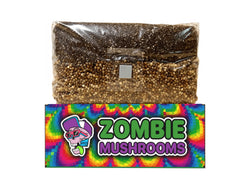Can Psychedelics Relieve Anxiety Without Hallucinations?
Interest in the therapeutic potential of psychedelics has surged in recent years, particularly for mental health issues like anxiety. However, a significant challenge to their medical use has been their hallucinogenic effects. Recent research suggests that the anxiety-reducing benefits of psychedelics may stem from different neural circuits than those responsible for hallucinations, opening possibilities for safer, non-hallucinogenic treatments.

The Neural Basis of Psychedelics
Psychedelics such as psilocybin, LSD, and DMT primarily interact with serotonin receptors in the brain, particularly the 5-HT2A receptor. Activation of this receptor is what leads to profound changes in perception, cognition, and mood. Scientists have long linked serotonin to emotional regulation, which explains why psychedelics have such strong potential for treating anxiety.
When psychedelics bind to 5-HT2A receptors, they increase neural plasticity, allowing the brain to reorganize and form new connections. This is particularly beneficial for conditions like anxiety and depression, which often involve rigid, maladaptive thought patterns. At the same time, these compounds disrupt normal sensory processing, leading to hallucinations or intense perceptual distortions.
The challenge has been that these two effects—psychological relief and hallucinogenic experiences—are closely intertwined. However, new research suggests they may not be as inseparable as once thought.

New Research on Neural Circuits
A major breakthrough in psychedelic research involves identifying distinct neural circuits that mediate their effects. Recent studies in animal models have provided strong indications that psychedelics relieve anxiety through different pathways than those responsible for hallucinations.
In a study published in Nature Neuroscience (Olson et al., 2023), researchers examined how LSD and psilocybin interacted with different brain regions. They discovered that the therapeutic effects appeared to stem from serotonin receptors in the prefrontal cortex—an area involved in emotion regulation—while hallucinogenic effects were more closely linked to activity in the thalamus and visual cortex.
These findings suggest it's possible to design psychedelics that target the therapeutic pathways while bypassing the circuits responsible for hallucinations. If proven in human studies, this could mark a turning point in psychiatric medicine, allowing patients to benefit from psychedelics without experiencing disorienting perceptual distortions.

Decoupling Anxiety Relief and Hallucinations
For psychedelics to become widely accepted in mainstream medicine, decoupling their anxiety-reducing properties from hallucinations is crucial. Currently, psychedelic-assisted therapy requires careful supervision because of the altered states of consciousness these compounds induce. But if researchers can isolate the neural mechanisms responsible for anxiety relief, new medication formulations could be developed that eliminate the need for hallucinogenic experiences.
Why is this important?
- Some patients are hesitant to take psychedelics because of their perceptual effects.
- Non-hallucinogenic alternatives could be more easily integrated into traditional medical settings.
- Removing hallucinations may make psychedelic-based treatments more acceptable to regulators and public health authorities.
This shift would mean that psychedelics could be developed similarly to conventional pharmaceuticals—taken at home without professional supervision—greatly expanding accessibility for individuals suffering from anxiety disorders.

The Role of the 5-HT2A Receptor
The 5-HT2A receptor is a key player in understanding how psychedelics work. It is heavily involved in brain function related to perception, cognition, and mood. When psychedelics activate this receptor, they trigger a cascade of effects that influence how the brain processes sensory information and emotions.
Some researchers hypothesize that by fine-tuning how psychedelics interact with the 5-HT2A receptor, it may be possible to preserve their mental health benefits while eliminating unwanted hallucinogenic effects. Low-dose psychedelics or modified compounds that deliver selective 5-HT2A activation may be the key to achieving this balance.

Implications for Psychedelic-Assisted Therapy
Psychedelic-assisted therapy has gained traction in recent years as a promising treatment for mental health disorders, but the hallucinogenic nature of these substances has remained a barrier. If non-hallucinogenic psychedelics become available, it could revolutionize the treatment landscape for anxiety, making these therapies more accessible to broader populations.
Here’s what a shift toward non-hallucinogenic psychedelics could mean:
- Better regulatory approval – Many psychedelics remain classified as controlled substances due to their hallucinogenic potential. A non-hallucinogenic version might face fewer legal restrictions.
- Wider adoption in medicine – Clinicians may be more comfortable prescribing psychedelics if patients don't need supervised hallucinogenic experiences.
- Increased patient willingness – Many individuals with anxiety may be hesitant to try psychedelics due to the fear of losing control during a trip—modifications could remove this concern.
Ethical and Medical Considerations
Despite these exciting findings, challenges must be addressed before non-hallucinogenic psychedelics become a reality.
Stigma in Medicine
Psychedelics have long been associated with counterculture movements and illegal use, which creates stigma in the medical community. Overcoming this bias will require extensive research and education to demonstrate their therapeutic benefits.
Safety Concerns
Hallucinogenic experiences, while disorienting, may play a role in lasting therapeutic benefits. Removing them entirely raises questions about whether the new medications will be as effective. More research is needed to confirm that non-hallucinogenic compounds provide the same long-term improvements seen in traditional psychedelic therapy.
Accessibility and Cost
Psychedelic treatments, especially in clinical settings, can be expensive and require specialized facilities. If non-hallucinogenic psychedelics are developed, they could reduce costs by eliminating the need for supervised administration, but ensuring affordability will remain an important challenge.

A Look at Future Studies
As researchers work to develop modified psychedelics that target specific neural circuits, the next steps involve human trials to confirm their efficacy. Future studies may explore:
- How different psychedelic formulations impact emotional well-being without inducing hallucinations.
- Long-term effects of non-hallucinogenic psychedelic compounds on anxiety and depression.
- Whether certain dose modifications can achieve therapeutic benefits while minimizing perceptual distortions.
As this field advances, new compounds may emerge that provide anxiety relief similar to traditional psychedelics but in a form that is safer, more manageable, and widely accessible.

The Connection to Mycology
Many of the findings related to non-hallucinogenic psychedelics stem from research into psilocybin mushrooms. The broader field of mycology is essential to understanding how naturally occurring compounds influence human neurobiology. Advancements in psychedelic medicine may not only lead to better treatments for anxiety but also expand our knowledge of how fungi affect health and wellness.
Conclusion
The possibility of using psychedelics for anxiety relief without hallucinations represents an exciting transformation in mental health research. By identifying the neural circuits responsible for therapeutic effects, scientists may develop safer, non-hallucinogenic psychedelic treatments. These advancements could pave the way for new, widely accepted anxiety medications that provide relief without cognitive impairment, marking a new era in psychiatric medicine.
FAQs
How do psychedelics interact with neural circuits to produce therapeutic effects?
Psychedelics influence serotonin receptors, particularly 5-HT2A, which impact mood regulation and promote long-lasting anxiety relief.
What does recent research suggest about separating anti-anxiety benefits from hallucinogenic effects?
Studies indicate that distinct brain pathways mediate anxiety reduction and hallucinations, suggesting they can be targeted separately.
How could this lead to safer psychedelic-based treatments?
By eliminating hallucinations while retaining therapeutic benefits, psychedelics could become more accessible and widely accepted for mental health.
What specific neurotransmitters and pathways are involved?
Serotonin pathways, particularly those linked to the 5-HT2A receptor, are the primary focus of recent psychedelic research.
Could this research impact the future of anxiety medication?
Yes, it may lead to the development of new, non-hallucinogenic treatments that provide the same anxiety-relieving benefits as psychedelics.
Citations
- Olson, D. E., et al. (2023). "Neural mechanisms underlying the therapeutic and hallucinogenic effects of psychedelics." Nature Neuroscience.
- Cameron, L. P., et al. (2022). "Decoupling hallucinogenic and therapeutic effects of psychedelics." Journal of Psychopharmacology.
- Carhart-Harris, R. L., & Nutt, D. J. (2017). "Serotonin and brain function: A role in psychedelic therapy?" Neuroscience & Biobehavioral Reviews.
Stay informed about the latest developments in psychedelic research, and explore how science is transforming mental health treatment.




